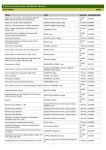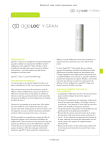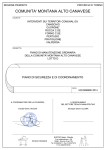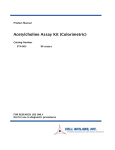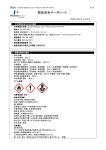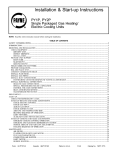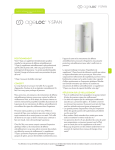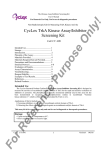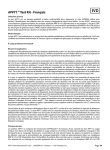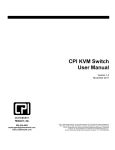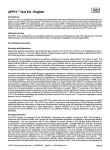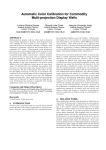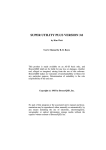Download CY-1081
Transcript
On ly! Pyk2 Kinase Assay/Inhibitor Screening Kit User’s Manual For Research Use Only, Not for use in diagnostic procedures Non-Radioisotopic Kit for Measuring Pyk2 Kinase Activity CycLex Pyk2 Kinase Assay/Inhibitor Screening Kit Pu rp Intended Use................................................ 1 Storage......................................................... 1 Introduction.................................................. 2 Principle of the Assay.................................. 3 Materials Provided....................................... 4 Materials Required but not Provided........... 4 Precautions and Recommendations............. 5 Detailed Protocol......................................... 6-8 Evaluation of Results................................... 9 Assay Characteristics................................... 9 Troubleshooting........................................... 9 Reagent Stability.......................................... 9 Example of Test Results............................. 10-12 References................................................... 13 Related Products..........................................14 os e Cat# CY-1081 ce Intended Use en The CycLex Research Product CycLex Pyk2 Kinase Assay/Inhibitor Screening Kit is designed to measure the activities of recombinant catalytic domain of Pyk2 (Proline-rich Tyrosine Kinase 2) for the rapid and sensitive evaluation of inhibitors or activators. The phosphotyrosine specific monoclonal antibody used in this assay kit has been demonstrated to recognize the phosphotyrosine residue in recombinant “Tyrosine kinase-substrate-1”, which is efficiently phosphorylated by Pyk2 in vitro. er Applications of this kit include: 1) Screening inhibitors or activators of recombinant catalytic domain of Pyk2. 2) Detecting the effects of pharmacological agents on recombinant catalytic domain of Pyk2. This assay kit is for research use only and not for use in diagnostic or therapeutic procedures. Storage rR ef • Upon receipt store all components at 4°C. • Don’t expose reagents to excessive light. Fo Cat#: CY-1081 1 Version#: 140318 On ly! Pyk2 Kinase Assay/Inhibitor Screening Kit User’s Manual For Research Use Only, Not for use in diagnostic procedures Introduction ce Measurement of Pyk2 Kinase activity Pu rp os e Intracellular signal transduction following extracellular ligation by a wide variety of surface molecules involves the activation and tyrosine phosphorylation of protein tyrosine kinases (PTKs). Tyrosine phosphorylation, controlled by the coordinated actions of protein tyrosine phosphatases and tyrosine kinases, is a critical regulatory mechanism for various physiological processes, including cell growth, differentiation, metabolism, cell cycle regulation and cytoskeleton function. The focal adhesion PTK family consists of the focal adhesion kinase (FAK) and the Pyk2 kinase (also known as RAFTK, CAK-beta and CADTK). Pyk2 kinase can be activated in response to various stimuli, such as TNF-alpha, changes in osmolarity, elevation in intracellular calcium concentration, lysophosphatidic acid, in addition of bradykinin, a neuropeptide hormone that binds to a G protein-coupled receptor and in turn stimulates phosphatidylinositol hydrolysis. Pyk2 kinase is expressed mainly in the central nervous system and in cells derived from hematopoietic lineages (1-3), while FAK is widely expressed in various tissues and links transmembrane integrin receptors to intracellular pathways. Lev et al showed that the Pyk2 protein undergoes rapid tyrosine phosphorylation in response to various stimuli, Pyk2 is also tyrosine phosphorylated following activation of the nicotinic acetylcholine receptor, by membrane depolarization, and by treatment of cells with a calcium ionophore (4). It has been proposed that Pyk2 may represent an important signaling intermediate between neuropeptide activated receptors or neurotransmitters that increase calcium flux and the downstream signals that regulate neuronal activity. Pyk2 may also provide a mechanism for a variety of short- and long-term calcium-dependent signaling events in the nervous system (2, 4). Activation of Pyk2 leads to the modulation of ion channel function and activation of the MAP kinase signaling pathway including p38 cacade (5-7). Furthermore, overexpression of Pyk2 led to activation of JNK, and a dominant-negative mutant of Pyk2 interfered with ultraviolet light- or osmotic shock-induced activation of JNK. Pyk2 represents a cell type-specific, stress-sensitive mediator of the JNK signaling pathway (8). rR ef er en The protocol generally regarded as most sensitive for the quantitative measurement of Pyk2 kinase activity involves incubation of the Pyk2 kinase sample with substrate, either a natural or synthetic polypeptide (such as poly[Glu,Tyr]4:1), in the presence of Mg2+, Mn2+ and 32P-labeled ATP. The reaction is terminated by "spotting" a sample onto a filter paper disc, followed by immersion in acid to precipitate the radiolabeled product. The filter papers are then washed extensively to remove unincorporated radiolabel and the radioactivity is counted. While sensitive, this method is labor-intensive, generates hazardous radioactive waste, and depends on a radioisotope of short half-life. It is particularly unsuitable when kinase assays are only performed on an infrequent basis. The CycLex Research Product CycLex Pyk2 Kinase Assay/Inhibitor Screening Kit uses a horseradish peroxidase coupled anti-phosphotyrosine monoclonal antibody as a reporter molecule in a 96-wells ELISA format. This assay provides a non-isotopic, sensitive and specific method to detect kinase activity of recombinant Pyk2 catalytic domain. Fo Cat#: CY-1081 2 Version#: 140318 On ly! Pyk2 Kinase Assay/Inhibitor Screening Kit User’s Manual For Research Use Only, Not for use in diagnostic procedures Principle of the Assay Pu rp os e The CycLex Research Product CycLex Pyk2 Kinase Assay/Inhibitor Screening Kit is a single-site, semi-quantitative immunoassay for kinase activity of recombinant catalytic domain of Met. Plates are pre-coated with a newly designed “Tyrosine kinase-substrate-1”, which can be easily phosphorylated by recombinant catalytic domain of Met. The detector antibody is PY-39, an antibody that specifically detects the phosphotyrosine residue on “Tyrosine kinase-substrate-1”. The CycLex Research Product CycLex Pyk2 Kinase Assay/Inhibitor Screening Kit might be used to follow the kinetics of recombinant catalytic domain of Pyk2 as well as screening Pyk2 inhibitor or activator. To perform the test, the recombinant catalytic domain of Pyk2 is diluted in Kinase Buffer, pipetted into the wells and allowed to phosphorylate “Tyrosine kinase-substrate-1” on the wells in the presence of Mg2+, Mn2+ and ATP. The amount of phosphorylated “Tyrosine kinase-substrate-1” is measured by binding it with a horseradish peroxidase conjugate of PY-39, a anti-phosphotyrosine monoclonal antibody, which then catalyzes the conversion of the chromogenic substrate tetra-methylbenzidine (TMB) from a colorless solution to a blue solution (or yellow after the addition of stopping reagent). The color is quantified by spectrophotometry and reflects the relative amount of Pyk2 kinase activity in the sample. For kinetic analysis, the recombinant catalytic domain of Pyk2 is added to the wells in a similar fashion and at varying times the reaction is stopped by the addition of a chelator, sodium ethylenediaminetetraacetate (EDTA) and the amount of phosphorylated substrate determined as before. The CycLex Research Product CycLex Pyk2 Kinase Assay/Inhibitor Screening Kit is designed to determine non-isotopic kinetic analysis of the Pyk2 catalytic domain kinase activity. Careful attention to operation and the assay protocol will provide the investigator with a reliable tool for the evaluation of inhibitor or activator of Pyk2 kinase. Summary of Procedure Add 100 µL of reaction mixture to the wells ce Incubate for 60 min at 30°C Wash the wells en Add 100 µL of HRP conjugated anti-phosphotyrosine antibody Incubate for 60 min at room temp. Wash the wells er Add 100 µL of Substrate Reagent ef Add 100 µL of Stop Solution rR Measure absorbance at 450 nm Fo Cat#: CY-1081 3 Version#: 140318 On ly! Pyk2 Kinase Assay/Inhibitor Screening Kit User’s Manual For Research Use Only, Not for use in diagnostic procedures Materials Provided All samples and standards should be assayed in duplicate. The following components are supplied and are sufficient for the one 96-wells microtiter plate kit. Microplate: One microplate supplied ready to use, with 96 wells (12 strips of 8-wells) in a foil, zip-lock bag with a desiccant pack. Wells are coated with recombinant “Tyrosine kinase-substrate-1”. 10X Wash Buffer: One bottle containing 100 mL of 10X buffer containing 2 %Tween®-20 os e Kinase Buffer: One bottle containing 20 mL of 1X buffer used for Kinase Reaction Buffer and sample dilution. 20X ATP: One vial of lyophilized ATP Na2 salt. HRP conjugated Detection Antibody: One bottle containing 12 mL of HRP (horseradish peroxidase) conjugated anti-phosphotyrosine monoclonal antibody (PY-39). Ready to use. Pu rp Substrate Reagent: One bottle containing 20 mL of the chromogenic substrate, tetra-methylbenzidine (TMB). Ready to use. Stop Solution: One bottle containing 20 mL of 1 N H2SO4. Ready to use. Materials Required but not Provided rR ef er en ce • Pyk2 Positive Control: One vial contains 100 units recombinant catalytic domain of Pyk2. The Positive Control should be added to the first well at 1 unit/well. For instance, in the case of 100 units/100 µL Pyk2 Positive Control, diluted Positive Control 1:10 with Kinase Buffer, use 10 µL for 1 assay. The Positive Control is separately delivered with a dry ice from other kit components. The Positive Control should be stored in aliquots at below -70°C. Avoid repeated freeze and thaw. • 10X Staurosporine (100 µM): Staurosporine is available from Sigma, Cat#. S-4400. 10 mM stock solution (DMSO) diluted 1:100 in Kinase Buffer. • 10X 2,5-MeC (methyl 2,5-dihydroxycinnamate): 100 µM 2,5-MeC (Kyowa Medix, Japan Cat#: OP11: make 5 mM DMSO solution and diluted 1:50 in water) • 10X Quercetin dihydrate: 500 µM Quercetin dihydrate (Sigma Cat# Q-0125: make 10 mM DMSO solution and diluted 1:20 in water) • Pipettors: 2-20 µL, 20-200 µL and 200-1000 µL precision pipettors with disposable tips. • Precision repeating pipettor • Wash bottle or multichannel dispenser for plate washing. • Microcentrifuge and tubes for sample preparation. • Vortex mixer • Plate reader capable of measuring absorbance in 96-wells plate at dual wavelengths of 450 nm/540 nm. Dual wavelengths of 450/550 or 450/595 nm can also be used. The plate can also be read at a single wavelength of 450 nm, which will give a somewhat higher reading. • Reagent reservoirs • Deionized water of the highest quality Fo Cat#: CY-1081 4 Version#: 140318 Precautions and Recommendations On ly! Pyk2 Kinase Assay/Inhibitor Screening Kit User’s Manual For Research Use Only, Not for use in diagnostic procedures • Store the ATP at -20°C in aliquots. Store all other components at 4°C. Do not expose reagents to excessive light. Avoid freeze/thaw cycles. • Allow all the components to come to room temperature before use. • Do not use kit components beyond the indicated kit expiration date. os e • Use only the microtiter wells provided with the kit. • Rinse all detergent residue from glassware. • Use deionized water of the highest quality. • Do not mix reagents from different kits. Pu rp • The buffers and reagents in this kit may contain preservatives or other chemicals. Care should be taken to avoid direct contact with these reagents. • Do not mouth pipet or ingest any of the reagents. • Do not smoke, eat, or drink when performing the assay or in areas where samples or reagents are handled. • Dispose of tetra-methylbenzidine (TMB) containing solutions in compliance with local regulations. • Avoid contact with Substrate Solution which contains hydrogen peroxide. ce • Avoid contact with Stop Solution which contains Sulfuric Acid. • In case of contact with the Stop Solution and the Substrate Solution, wash skin thoroughly with water and seek medical attention, when necessary. en • Biological samples may be contaminated with infectious agents. Do not ingest, expose to open wounds or breathe aerosols. Wear protective gloves and dispose of biological samples properly. rR ef er • CAUTION: Sulfuric Acid is a strong acid. Wear disposable gloves and eye protection when handling Stop Solution. Fo Cat#: CY-1081 5 Version#: 140318 On ly! Pyk2 Kinase Assay/Inhibitor Screening Kit User’s Manual For Research Use Only, Not for use in diagnostic procedures Detailed Protocol The CycLex Research Product CycLex Pyk2 Kinase Assay/Inhibitor Screening Kit is provided with removable strips of wells so the assay can be carried out on separate occasions using only the number of strips required for the particular determination. Due to technical reason, this kit is adjusted to measure kinase activity of the recombinant catalytic domain of Pyk2 (CycLex Pyk2 Positive Control; not provided, CY-E1081), should be used in all assay. Disposable pipette tips and reagent troughs should be used for all liquid transfers to avoid cross-contamination of reagents or samples. os e Preparation of Working Solution 1. Prepare a working solution of Wash Buffer by adding 100 mL of the 10X Wash Buffer (provided) to 900 mL of ddH2O. Mix well. Store at 4°C for two weeks or -20°C for long-term storage. 2. Prepare 20X ATP Solution by adding 1.6 mL of ddH2O to the vial of 20X ATP (provided, lyophilized). Mix gently until dissolved. The final concentration of the 20X ATP Solution should be 1.25 mM. Store the solution in small aliquots (e.g. 100 µL) at -20°C. Kinase Buffer (provided) 20X ATP Solution Total Pu rp 3. Prepare Kinase Reaction Buffer by mixing following reagents. 96 assays 10 assays 1 assay 9.5 mL 0.5 mL 950 µL 50 µL 95 µL 5 µL 10 mL 1000 µL 100 µL ce You will need 80-90 µL of Kinase Reaction Buffer per assay well. Mix well. Discard any unused Kinase Reaction Buffer after use. Standard Assay en 1. Remove the appropriate number of microtiter wells from the foil pouch and place them into the well holder. Return any unused wells to the foil pouch, refold, seal with tape and store at 4°C. 2. Prepare the Kinase Assay Buffer containing test chemicals and tyrosine kinase inhibitor (see page 8). All assays should be done in duplicate. er 3. Add 10 µL of 0.1 unit/µL Pyk2 Positive Control or serial dilution of Pyk2 Positive Control to the wells of the assay plate on ice. ef 4. Begin the kinase reaction by addition of 90 µL Kinase Reaction buffer per well, cover with plate sealer, and incubate at 30°C for 60 minutes. 5. Wash wells five times with Wash Buffer making sure each well is filled completely. Remove residual Wash Buffer by gentle tapping or aspiration. rR 6. Pipette 100 µL HRP conjugated Detection Antibody into each well, cover with a plate sealer and incubate at room temperature (ca.25°C) for 60 minutes. Discard any unused conjugate. Fo Cat#: CY-1081 6 Version#: 140318 On ly! Pyk2 Kinase Assay/Inhibitor Screening Kit User’s Manual For Research Use Only, Not for use in diagnostic procedures 7. Wash wells five times with Wash Buffer making sure each well is filled completely. Remove residual Wash Buffer by gentle tapping or aspiration. 8. Add 100 µL of Substrate Reagent to each well and at room temperature (ca.25°C) for 5–15 minutes. 9. Add 100 µL of Stop Solution to each well in the same order as the previously added Substrate Reagent. os e 10. Measure absorbance in each well using a spectrophotoPyk2ric plate reader at dual wavelengths of 450/540 nm. Dual wavelengths of 450/550 or 450/595 nm can also be used. Read the plate at 450 nm if only a single wavelength can be used. Wells must be read within 30 minutes of adding the Stop Solution. Note-1: Complete removal of liquid at each step is essential to good performance. After the last wash, remove any remaining Wash Buffer by aspirating or decanting. Invert the plate and blot it against clean paper towels. Pu rp Note-2: Reliable signals are obtained when either O.D. values do not exceed 0.25 units for the blank (no enzyme control), or 2.5 units for the Pyk2 Positive Control. Note-3: If the microplate reader is not capable of reading absorbance greater than the absorbance of the Pyk2 Positive Control, perform a second reading at 405 nm. A new O.D. values, measured at 405 nm, is used to determine Pyk2 activity of off-scale samples. The readings at 405 nm should not replace the on-scale readings at 450 nm. Kinetic Assay ce 1. Remove the appropriate number of microtiter wells from the foil pouch and place them into the well holder. Return any unused wells to the foil pouch, refold, seal with tape and store at 4°C. 2. Prepare all samples (diluted with Kinase Buffer as needed). All samples should be assayed in duplicate. en 3. Add 10 µL of 0.1 unit/µL Pyk2 Positive Control or serial dilution of Pyk2 Positive Control to the wells of the assay plate on ice. er 4. Begin kinase reaction by addition of 90 µL Kinase Reaction Buffer in duplicate per well in timed intervals (suggested interval is 5 minutes but should be individually determined for each system). After the final addition, incubate at 30°C for 20 minutes. 5. Stop the reaction by flicking out the contents. (Alternatively, the reaction may be terminated by the addition of 150 µL 0.1 M Na EDTA, pH 8.0 to each well). ef 6. Wash wells five times with Wash Buffer making sure each well is filled completely. Remove residual Wash Buffer by gentle tapping or aspiration. rR 7. Pipette 100 µL HRP conjugated Detection Antibody into each well, cover with a plate sealer and incubate at room temperature (ca.25°C) for 60 minutes. Discard any unused conjugate. 8. Wash wells five times with Wash Buffer making sure each well is filled completely. Remove Fo Cat#: CY-1081 7 Version#: 140318 On ly! Pyk2 Kinase Assay/Inhibitor Screening Kit User’s Manual For Research Use Only, Not for use in diagnostic procedures residual Wash Buffer by gentle tapping or aspiration. 9. Add 100 µL of Substrate Reagent to each well and incubate at room temperature (ca.25°C) for 5-15 minutes. 10 add 100 µL of Stop Solution to each well in the same order as the previously added Substrate Reagent. os e 11. Measure absorbance in each well using a spectrophotometric plate reader at dual wavelengths of 450/540 nm. Dual wavelengths of 450/550 or 450/595 nm can also be used. Read the plate at 450 nm if only a single wavelength can be used. Wells must be read within 30 minutes of adding the Stop Solution. Recommendations Assay reagents Kinase Reaction Buffer 10X Inhibitor or equivalent Solvent for Inhibitor Pu rp Special considerations when screening activators and inhibitors In order to estimate the inhibitory effect on Pyk2 activity in the test chemicals correctly, it is necessary to conduct the control experiment of “Solvent control” at least once for every experiment and “Inhibitor control” at least once for the first experiment, in addition to “Test sample”, as indicated in the following table. When test chemicals cause an inhibitory effect on Pyk2 activity, the level of A450 is weakened as compared with “Solvent control”. The high level of A450 is not observed in “Inhibitor control” (usually A450<0.5). 80 µL Solvent control 80 µL Inhibitor control 80 µL 10 µL - - - 10 µL - - - 10 µL 10 µL 10 µL 10 µL Test sample ce 10X Staurosporine (100 µM)* CycLex Pyk2 Positive Control (0.1 unit/µL)** en * 10X Staurosporine (100 µM): See page 4, section “Materials Required but not Provided” ** Pyk2 Positive Control (0.1 unit/µL)**: See page 4, section “Materials Required Provided” 1. Following the above table, add the Reagents to each well of the microplate. Finally, initiate reaction by adding 10 µL of “Diluted CycLex Pyk2 Positive Control ” to each well and mixing thoroughly at room temperature. Cover with plate sealer. Incubate at 30°C for 60 minutes. rR ef er 2. Follow the Standard Assay, steps 5-10, page 6-7. Fo Cat#: CY-1081 8 Version#: 140318 On ly! Pyk2 Kinase Assay/Inhibitor Screening Kit User’s Manual For Research Use Only, Not for use in diagnostic procedures Evaluation of Results 1. Average the absorbance values for the Pyk2 sample duplicates (Positive Control) and all experimental sample duplicate values (when applicable). When the Pyk2 Positive Control (1 unit/assay) is included as an internal control for the phosphorylation reaction, the absorbance value should be greater than 1.0 with a background less than 0.2. 2. For kinetic analysis, on graph paper, plot the mean absorbance values for each of the time points on the Y-axis versus the time of each reaction (minutes) on the X-axis. os e Assay Characteristics The CycLex Research Product CycLex Pyk2 Kinase Assay/Inhibitor Screening Kit has been shown to detect the kinase activity of recombinant catalytic domain of Pyk2. The assay shows good linearity of sample response. Pu rp Troubleshooting 1. The Pyk2 Positive Control should be run in duplicate, using the protocol described in the Detailed Protocol. Incubation times or temperatures significantly different from those specified may give erroneous results. 2. The reaction curve is nearly a straight line if the kinetics of the assay is of the first order. Variations in the protocol can lead to non-linearity of the curve, as can assay kinetics that are other than first order. For a non-linear curve, point to point or quadratic curve fit methods should be used. ce 3. Poor duplicates, accompanied by elevated values for wells containing no sample, indicate insufficient washing. If all instructions in the Detailed Protocol were followed accurately, such results indicate a need for washer maintenance. 4. Overall low signal may indicate that desiccation of the plate has occurred between the final wash and addition of Substrate Reagent. Do not allow the plate to dry out. Add Substrate Reagent immediately after wash. en Reagent Stability er All of the reagents included in the CycLex Research Product CycLex Pyk2 Kinase Assay/Inhibitor Screening Kit have been tested for stability. Reagents should not be used beyond the stated expiration date. Upon receipt, kit reagents should be stored at 4°C. Coated assay plates should be stored in the original foil bag sealed by the zip lock and containing a desiccant pack. rR ef For research use only, not for use in diagnostic or therapeutic procedures Fo Cat#: CY-1081 9 Version#: 140318 Example of Test Results Fig.1 Dose dependency of recombinant Pyk2 catalytic domain enzyme reaction 2.00 On ly! Pyk2 Kinase Assay/Inhibitor Screening Kit User’s Manual For Research Use Only, Not for use in diagnostic procedures os e 1.50 A4 5 0 ATP + ATP - 1.00 0.00 0.0 1.0 Pu rp 0.50 2.0 3.0 4.0 P yk2 do se (u n it) Fig.2 Time course of recombinant Pyk2 catalytic domain enzyme reaction ce 2.0 1.0 er 0.5 en A4 50 1.5 ef 0.0 rR 0 Fo Cat#: CY-1081 20 40 60 80 100 R e ac t io n t ime (min .) 10 Version#: 140318 On ly! Pyk2 Kinase Assay/Inhibitor Screening Kit User’s Manual For Research Use Only, Not for use in diagnostic procedures Fig.3-1 Dose dependency of ATP (recombinant Pyk2 catalytic domain) Do se de pe n de n c y o f ATP 2.00 os e A4 5 0 1.50 1.00 Pu rp 0.50 0.00 0 20 40 60 ATP c o n c . (u M) 80 100 ce Fig.3-2 Km for ATP (recombinant Pyk2 catalytic domain) 5000.0 en 4000.0 y = 45.409x + 134.72 R2 = 0.9984 2000.0 er < s/ v> 3000.0 Km for ATP : 2.96uM 1000.0 ef 0.0 rR 0 Fo Cat#: CY-1081 20 40 60 80 100 < s> 11 Version#: 140318 On ly! Pyk2 Kinase Assay/Inhibitor Screening Kit User’s Manual For Research Use Only, Not for use in diagnostic procedures Fig.4 Effect of broad-spectrum kinase inhibitor Staurosporine on activity of recombinant Pyk2 catalytic domain enzyme reaction 125.0 75.0 os e Relative Intensity(%) 100.0 50.0 0.0 0.0001 0.001 Pu rp 25.0 0.01 0.1 1 10 100 rR ef er en ce Staurosporine conc. (uM) Fo Cat#: CY-1081 12 Version#: 140318 On ly! Pyk2 Kinase Assay/Inhibitor Screening Kit User’s Manual For Research Use Only, Not for use in diagnostic procedures References 1. Menegon A, Burgaya F, Baudot P, Dunlap DD, Girault JA, Valtorta F. FAK+ and PYK2/CAKbeta, two related tyrosine kinases highly expressed in the central nervous system: similarities and differences in the expression pattern. Eur J Neurosci 11:3777-3788, 1999 2. Girault JA, Costa A, Derkinderen P, Studler JM, Toutant M. FAK and PYK2/CAKbeta in the nervous system: a link between neuronal activity, plasticity and survival? Trends Neurosci 22:257-263, 1999 os e 3. Gismondi A, Bisogno L, Mainiero F, Palmieri G, Piccoli M, Frati L, Santoni A. Proline-rich tyrosine kinase-2 activation by beta 1 integrin fibronectin receptor cross-linking and association with paxillin in human natural killer cells. J Immunol 159:4729-4736, 1997 4. Lev, S.; Moreno, H.; Martinez, R.; Canoll, P.; Peles, E.; Musacchio, J. M.; Plowman, G. D.; Rudy, B.; Schlessinger, J.: Protein tyrosine kinase PYK2 involved in Ca(2+)-induced regulation of ion channel and MAP kinase functions. Nature 376: 737-745, 1995. Pu rp 5. Dikic I, Tokiwa G, Lev S, Courtneidge SA, Schlessinger J. A role for Pyk2 and Src in linking G-protein-coupled receptors with MAP kinase activation. Nature 383:547-550, 1996 6. Takaoka A, Tanaka N, Mitani Y, Miyazaki T, Fujii H, Sato M, Kovarik P, Decker T, Schlessinger J, Taniguchi T. Protein tyrosine kinase Pyk2 mediates the Jak-dependent activation of MAPK and Stat1 in IFN- , but not IFN- , signaling. EMBO J 18:2480-2488, 1999 ce 7. Pandey P, Avraham S, Kumar S, Nakazawa A, Place A, Ghanem L, Rana A, Kumar V, Majumder PK, Avraham H, Davis RJ, Kharbanda S. Activation of p38 mitogen-activated protein kinase by PYK2/related adhesion focal tyrosine kinase-dependent mechanism. J Biol Chem 274:10140-10144, 1999 rR ef er en 8. Tokiwa G, Dikic I, Lev S, Schlessinger J. Activation of Pyk2 by stress signals and coupling with JNK signaling pathway. Science 273:792-794, 1996 Fo Cat#: CY-1081 13 Version#: 140318 Related Products Pu rp er en PRODUCED BY CycLex Co., Ltd. 1063-103 Terasawaoka Ina, Nagano 396-0002 Japan Fax: +81-265-76-7618 e-mail: [email protected] URL: http://www.cyclex.co.jp ce Tyrosine Kinase Positive Control * Wee1 Positive Control: Cat# CY-E1172 * Met Positive Control: Cat# CY-E1080 * Pyk2 Positive Control: Cat# CY-E1081 * FGFR2 Positive Control: Cat# CY-E1082 * c-Src Positive Control: Cat# CY-E1083 * p56Lck Positive Control: Cat# CY-E1084 * TrkA Positive Control: Cat# CY-E1091 * EphA2 Positive Control: Cat# CY-E1092 os e Tyrosine Kinase Assay Kit * CycLex Wee1 Kinase Assay/Inhibitor Screening Kit: Cat# CY-1172 * CycLex Met Kinase Assay/Inhibitor Screening Kit: Cat# CY-1080 * CycLex Pyk2 Kinase Assay/Inhibitor Screening Kit: Cat# CY-1081 * CycLex FGFR2 Kinase Assay/Inhibitor Screening Kit: Cat# CY-1082 * CycLex c-Src Kinase Assay/Inhibitor Screening Kit: Cat# CY-1083 * CycLex p56Lck Kinase Assay/Inhibitor Screening Kit: Cat# CY-1084 * CycLex TrkA Kinase Assay/Inhibitor Screening Kit: Cat# CY-1091 * CycLex EphA2 Kinase Assay/Inhibitor Screening Kit: Cat# CY-1092 On ly! Pyk2 Kinase Assay/Inhibitor Screening Kit User’s Manual For Research Use Only, Not for use in diagnostic procedures rR ef CycLex/CircuLex products are supplied for research use only. CycLex/CircuLex products and components thereof may not be resold, modified for resale, or used to manufacture commercial products without prior written approval from CycLex Co., Ltd.. To inquire about licensing for such commercial use, please contact us via email. Fo Cat#: CY-1081 14 Version#: 140318














